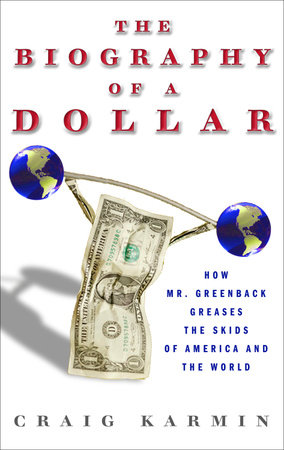Will the sun set on the greatest currency in the history of the world?
For decades the dollar has been the undisputed champ. It’s not only the currency of America but much of the world as well, the fuel of global prosperity. As the superengine of the world’s only superpower, it’s accepted everywhere. When an Asian company trades with South America, those transactions are done in dollars, the currency of international business.
But for how much longer? Economists fear America is digging a hole with an economy based on massive borrowing and huge deficits that cloud the dollar’s future. Will the buck be eclipsed by the euro or even China’s renminbi? Should Americans worry when the value of the mighty U.S. dollar sinks to par with the Canadian “loonie”?
Craig Karmin’s in-depth “biography” of the dollar explores these issues. It also examines the green-back’s history, allure, and unique role as a catalyst for globalization, and how the American buck became so almighty that $ became perhaps the most powerful symbol on earth.
Biography of the Dollar explores every aspect of its subject: the power of the Federal Reserve, the inner sanctums of foreign central banks that stockpile the currency, and the little-known circles of foreign exchange traders that determine a currency’s worth. It traces the dollar’s ascendancy, including one incredibly important duck-hunting trip and the world-changing Bretton Woods Conference.
With its watermark, color-shifting inks, and a presidential portrait that glows under ultraviolet light, the dollar has obsessed foreign governments, some of which have tried to counterfeit it. Even Saddam Hussein, who insisted on being paid in euros for oil, had $750,000 in hundred-dollar bills when captured. Yet if a worldwide currency has enabled a global economy to flourish, it’s also allowed the United States to owe unbelievable, shocking amounts of money—paying hundreds of millions of dollars every single day just in interest on foreign debt; that’s raised concerns that the dollar standard may not be sustainable.
Any threat to the dollar’s privileged status would do much more than hurt American pride. It would mean U.S. companies and citizens would not be able to borrow at the low rates they have become accustomed to. The dollar’s demise would impact the rest of the world, too, boosting the costs of trade and investment if no other currency was able to play the same crucial role. Ultimately the dollar system may weaken, but it should endure—a while longer, at least; it’s in few people’s interest to see it fail, and there is still no credible alternative.
Biography of the Dollar is must reading for anyone who wants to understand what truly makes the world go ’round—and whether it will continue to spin the way we want it to.







